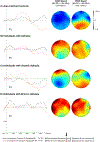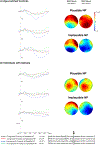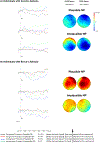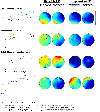Electrophysiology of prosodic and lexical-semantic processing during sentence comprehension in aphasia
- PMID: 29061490
- PMCID: PMC6530485
- DOI: 10.1016/j.neuropsychologia.2017.10.023
Electrophysiology of prosodic and lexical-semantic processing during sentence comprehension in aphasia
Abstract
Event-related potentials (ERPs) were used to examine how individuals with aphasia and a group of age-matched controls use prosody and themattic fit information in sentences containing temporary syntactic ambiguities. Two groups of individuals with aphasia were investigated; those demonstrating relatively good sentence comprehension whose primary language difficulty is anomia (Individuals with Anomic Aphasia (IWAA)), and those who demonstrate impaired sentence comprehension whose primary diagnosis is Broca's aphasia (Individuals with Broca's Aphasia (IWBA)). The stimuli had early closure syntactic structure and contained a temporary early closure (correct)/late closure (incorrect) syntactic ambiguity. The prosody was manipulated to either be congruent or incongruent, and the temporarily ambiguous NP was also manipulated to either be a plausible or an implausible continuation for the subordinate verb (e.g., "While the band played the song/the beer pleased all the customers."). It was hypothesized that an implausible NP in sentences with incongruent prosody may provide the parser with a plausibility cue that could be used to predict syntactic structure. The results revealed that incongruent prosody paired with a plausibility cue resulted in an N400-P600 complex at the implausible NP (the beer) in both the controls and the IWAAs, yet incongruent prosody without a plausibility cue resulted in an N400-P600 at the critical verb (pleased) only in healthy controls. IWBAs did not show evidence of N400 or P600 effects at the ambiguous NP or critical verb, although they did show evidence of a delayed N400 effect at the sentence-final word in sentences with incongruent prosody. These results suggest that IWAAs have difficulty integrating prosodic cues with underlying syntactic structure when lexical-semantic information is not available to aid their parse. IWBAs have difficulty integrating both prosodic and lexical-semantic cues with syntactic structure, likely due to a processing delay.
Keywords: Aphasia; Event related potentials; N400; P600; Prosody; Sentence processing.
Copyright © 2017 Elsevier Ltd. All rights reserved.
Figures






Similar articles
-
Electrophysiological evidence for the interaction of prosody and thematic fit during sentence comprehension.Lang Cogn Neurosci. 2018;33(5):547-562. doi: 10.1080/23273798.2017.1390143. Epub 2017 Oct 25. Lang Cogn Neurosci. 2018. PMID: 29904641 Free PMC article.
-
Late interaction of syntactic and prosodic processes in sentence comprehension as revealed by ERPs.Brain Res Cogn Brain Res. 2005 Sep;25(1):130-43. doi: 10.1016/j.cogbrainres.2005.05.003. Brain Res Cogn Brain Res. 2005. PMID: 15967649
-
Influence of prosodic information on the processing of split particles: ERP evidence from spoken German.J Cogn Neurosci. 2005 Jan;17(1):154-67. doi: 10.1162/0898929052880075. J Cogn Neurosci. 2005. PMID: 15701246
-
Neural mechanisms of language comprehension: challenges to syntax.Brain Res. 2007 May 18;1146:23-49. doi: 10.1016/j.brainres.2006.12.063. Epub 2006 Dec 23. Brain Res. 2007. PMID: 17400197 Review.
-
Getting real about semantic illusions: rethinking the functional role of the P600 in language comprehension.Brain Res. 2012 Mar 29;1446:127-43. doi: 10.1016/j.brainres.2012.01.055. Epub 2012 Feb 2. Brain Res. 2012. PMID: 22361114 Review.
Cited by
-
Exploring neural tracking of acoustic and linguistic speech representations in individuals with post-stroke aphasia.Hum Brain Mapp. 2024 Jun 1;45(8):e26676. doi: 10.1002/hbm.26676. Hum Brain Mapp. 2024. PMID: 38798131 Free PMC article.
-
Using prosody during sentence processing in aphasia: Evidence from temporal neural dynamics.Neuropsychologia. 2019 Nov;134:107197. doi: 10.1016/j.neuropsychologia.2019.107197. Epub 2019 Sep 19. Neuropsychologia. 2019. PMID: 31542361 Free PMC article. No abstract available.
-
The time course of priming in aphasia: An exploration of learning along a continuum of linguistic processing demands.Top Lang Disord. 2020 Jan-Mar;40(1):54-80. doi: 10.1097/TLD.0000000000000205. Top Lang Disord. 2020. PMID: 32103849 Free PMC article.
-
Neural correlates of syntactic comprehension: A longitudinal study.Brain Lang. 2022 Feb;225:105068. doi: 10.1016/j.bandl.2021.105068. Epub 2021 Dec 31. Brain Lang. 2022. PMID: 34979477 Free PMC article.
-
Structural Priming in Aphasia: A State-of-the-Art Review and Future Directions.Aphasiology. 2024 Dec 25:10.1080/02687038.2024.2445660. doi: 10.1080/02687038.2024.2445660. Online ahead of print. Aphasiology. 2024. PMID: 40857540
References
-
- Altmann G (1999). Thematic role assignment in context. Journal of Memory and Language, 41, 124–145.
-
- Altmann GT, & Kamide Y (1999). Incremental interpretation at verbs: Restricting the domain of subsequent reference. Cognition, 73(3), 247–264. - PubMed
-
- Arai M, & Keller F (2013). The use of verb-specific information for prediction in sentence processing. Language and Cognitive Processes, 28(4), 525–560.
-
- Baum SR, & Dwivedi VD (2003). Sensitivity to prosodic structure in left-and right-hemisphere-damaged individuals. Brain and Language, 87(2), 278–289. - PubMed
-
- Blodgett AR (2004). The interaction of prosodic phrasing, verb bias, and plausibility during spoken sentence comprehension. The Ohio State University.
MeSH terms
Grants and funding
LinkOut - more resources
Full Text Sources
Other Literature Sources
Medical
Miscellaneous

